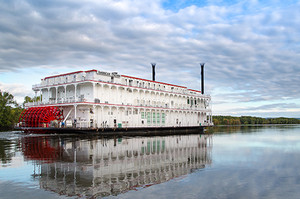
The eastern Mediterranean is the home of some of the great ancient civilisations where history and mythology combine, making it a heady mix of fantastic architecture and monuments, sun drenched beaches and the deep blue of the sea. It’s also a region which was, and still is, a crucial maritime trade route for the great civilisations; although empires have risen and fallen, and borders have been moved and removed, the societies built around the region remain congruous in their maritime culture. And for visitors by cruise ship, it’s a place to spend a day (or perhaps more), walking the cobblestone streets of ancient cities, swimming in a deserted bay, experiencing world class museums and cathedrals, and standing before magnificent antiquities with the added bonus of a new cultural experience almost every day. Here’s what you can discover in the top three cruising destinations across Turkey and Egypt.
Istanbul
As the sun drops and casts a warm orange hue across the city, the now-familiar Call to Prayer reverberates across the Bosphorus River from one of the many mosques that dominate the skyline. Traditional ferryboats cruise past carrying a mix of office workers on their way home, and suburbanites heading for an evening out, and on the outside decks many of the locals are sipping tea and taking in the magnificent view. In the distance, the Topkapi Palace, the Basilica of Saint Sophia and the Blue Mosque change colour as they’re lit up for the evening, as if to confirm these are the city’s crown jewels. After just a day in Istanbul, sensory overload has already kicked in and it’s no wonder this place is routinely called one of the great cities of Europe ... and Asia. Straddling the imposing Bosphorus River which serves as a geographic border, Istanbul literally has a foot in each continent and is at the crossroads of the West and the Islamic world.
For thousands of years it’s been a maritime city of great historical and strategic importance which began when the early Greeks founded the city as Byzantium in 658 BC. Since then the Persians, Alexander the Great, the Roman Empire and modern Turkish conquerors, were some of the world’s great empires which claimed Istanbul as their own. Sailing into, or out of, Istanbul is an experience which goes some way towards gaining a sense of its rich history and most cruises start and/or finish in this city because of the grand scale of its presence.
Many volumes have been written about Istanbul’s fascinating and historic past. Over 26 centuries, emperors, kings and sultans have all passed through Istanbul and left their mark on this vast, bustling metropolis, packed with remnants of past imperial might. The English writer Sir Sacheverell Sitwell summed up the grandeur of Istanbul in Arabesque and Honeycomb in 1957: “Our ship makes a sweep towards it and in that moment we see before and in front of us the opening of the Golden Horn, and one after another all the Imperial Mosques of Istanbul standing against and upon the skyline. It is the most sensational revelation: one after another of these great domes as in a panorama, they stand there like huge kettledrums with something menacing and martial in their air, and in that moment it is more of a capital than any other city, more than London, or than Rome, or Paris.”
Ephesus
One of Turkey’s other most popular tourist destinations is the ancient city of Ephesus which is the best preserved Aegean antiquity, and its intact state makes it one of the most important archaeological sites in the world. Wandering the smooth marble streets gives a very real sense of what life was like in ancient Greece or Rome. Kusadasi is the port that provides access to Ephesus, about 12km away, and the former has been transformed from a sleepy fishing town into a busy tourist hub thanks to the increasing number of cruise ships visiting the region. Ephesus was founded around 3000BC, and the empires of Greece, Persia, Rome, Byzantium and the Ottoman Turks at various times reigned over the city. At its peak in the second century AD it was the second largest city in the Roman Empire, behind Rome. At that time it was home to more than 250,000 people and was one of the most important ports in Europe with goods passing through from Asia to Greece and Italy. Perhaps the city’s greatest claim to fame is its temple to the goddess Artemis, which is one of the Seven Wonders of the Ancient World. It was almost four times the size of the Parthenon in Athens and sadly today only a few original columns remain.
Despite that, there is still enough ancient grandeur in Ephesus, including the Great Theatre which is built into the side of a hill and seated 25,000 people at one stage. It sits near Harbor Way and it’s hard to believe that Ephesus once had a harbour, as it’s now about 8km from the ocean, which silted up over time and perhaps led to the city’s ultimate demise. It can take anything from a few hours to a full day to explore Ephesus, and the best place to start is at the Magnesian Gate which is at the top of a hill. It means the exploration of the city is mostly a downhill walk which is an absolute godsend especially if the weather is hot, as it usually is.
Walking along Curettes Way, lined with the remains of a colonnade that shaded pedestrians, and ahead is another of the highlights of Ephesus, the Library of Celsus. The grand marble road leads down to one of the largest libraries of the ancient world which contained between 12,000 and 15,000 scrolls. The library was built between 110AD and 135AD in memory of Roman Senator Celsus Polemeanus, who was Proconsul of the Province of Asia. The facade of the Library has been restored to its original condition and its importance is that it’s one of the few remaining ancient Roman libraries which mostly followed the same classical architecture. At the entrance to the Library is a 21 metre wide courtyard paved in marble, and nine wide marble steps lead up to the main entrance. The tomb of Celsus remains inside and his life is celebrated in Greek and Latin on the bases of statues on each side of the library staircase.
Elsewhere other ruins include the Odeon, a small theatre built around 150AD which hosted smaller plays and concerts for up to two thousand people. It originally had a closed roof and the upper part of the theatre was decorated with red granite pillars. The Temple of Hadrian on Curettes Way was also built in the second century and is one of the more beautiful ruins and inside the temple is a relief of Medusa, and a frieze depicting gods and other mythological figures connected with the city. The Temple of Domitian is on a square where shops and stores once flourished and this was one of the biggest temples in Ephesus, and the State Agora or Town Hall occupies a massive piece of land which included a courtyard which led into the main building and contained different rooms and halls where city officials met.
The Pyramids Of Giza
One of the highlights of many Eastern Mediterranean cruises is a stop at Alexandria in Egypt, affording passengers the opportunity of a day-trip to to see the Pyramids of Giza, including the only remaining of the Seven Ancient Wonders of the World, the Great Pyramid. As your bus sweeps down into the dusty valley, with the bustling city of Cairo as a backdrop, seeing the three giant pyramids for the first time draws inevitable gasps. But a personal favourite photo op of ours is the view back at the pyramids from down the valley at the site of the Great Sphinx. The word sphinx, which means “strangler” was first given by the Greeks to an exotic creature which had the head of a woman, the body of a lion, and the wings of a bird. In Egypt, however, there are numerous sphinxes, usually with the head of a king adorned with a headdress, and the body of a lion.
The Sphinx is said to be the most immense stone sculpture made by man, and over the centuries since its creation it was buried in the sand. Between 1925 and 1936, however, it was excavated, and exposed to the elements once more. As millions of tourists flock each year to see the famous structure, it’s hard to imagine that had it not been for its sandy tomb over the years, the Sphinx wouldn’t be here today. But the burning question for many experts is: how long will it last this time? Being constructed of soft sandstone, this mysterious and beautiful statue is in severe danger from the wind, the humidity, and Cairo’s notorious smog. Every day it continues to erode, with pieces of limestone reportedly falling off the body during the intense heat of the day. As a result, much of the work taking place on the Sphinx isn’t focussed on further excavations, but rather its preservation. For both visitors who haven’t yet seen it, and for the Great Sphinx itself, time appears to be running out.
- By:
- Ben Hall











